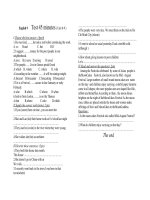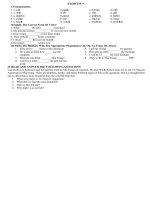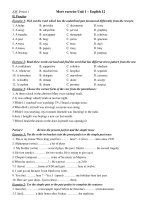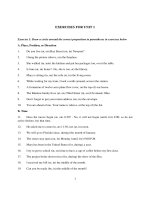Architecture English Exercise Unit 03
Bạn đang xem bản rút gọn của tài liệu. Xem và tải ngay bản đầy đủ của tài liệu tại đây (38.91 KB, 3 trang )
1
Exercises for unit 3
HOCHIMINH CITY UNIVERSITY OF ARCHITECTURE Ms LY
EXERCISES FOR UNIT 3 – GERUNDS AND GERUND PHRASES
Exercise 1: Complete these sentences with the gerund form of the words in parentheses and any other
necessary words
(Learn)___________ was a difficult job.
Learning all of those new words in one day was a difficult job.
1. That (learn) ________ is a process that is inferred from behavior.
2. The lumber must have low moisture content to avoid (loose) ________ of the drywall nails.
3. It became a universal practice in nearly all countries in the purchase of motor vehicles, and it
accustomed people (buy) ________ other durable consumer goods in the same way.
4. Some motorists are afraid of (be) ________ made guinea pigs for an unproved device.
5. The ring liner acts as a semifiexible system, capable of (adjust) ________ to the no uniform loads
imposed by the fractured clays that form the ridge.
6. The reason for her (leave) ________, her growing disillusionment with the system her father had built,
was deep and complex.
7. The equipment is capable of (operate) ________ on local commuter service or express service.
8. The German technical experts did an outstanding job in (design) ________ new devices to be used in
land, sea and air warfare. They were also successful in (turn) ________ them out in mass production.
9. This program is designed to demonstrate improved methods of (build) ________ and (maintain)
________ a highway system by giving on-the-job training to engineers and staff of the country's highway
department.
10. He may explain that he got tired of (use) _______ powder.
11. Analysts said that many Duma members did not want to risk (loose) _______ their seats—and the
privileges and resources that go with them—as they prepare to campaign for the December 1999
parliamentary elections.
12. Audiences had many choices in (seek) ________ out films worth abandoning VCRs for multiplexes.
13. The commission also said it did not view its call for more demanding academic work as an excuse for
(ignore) _______ the needs of disadvantaged students.
14. The whole situation was reviewed in a State Department White Paper on China, which explained the
reasons for (stop) ______ American aid to the Nationalists.
2
Exercises for unit 3
HOCHIMINH CITY UNIVERSITY OF ARCHITECTURE Ms LY
15. He cited as his reasons for (leave) _______ a "negative political milieu" and his belief that the state
did not have the economic resources to boost the university to national excellence.
THE GERUND AFTER PREPOSITIONS
Exercise 2: Supply the correct preposition in the blank space in each sentence. Use the Gerund form of
the verb in parentheses after the preposition
1. He always depends _____________ (get) help from other students.
2. Why did those fellows insist __________ (do) everything themselves ?
3. Did Mr. Johnson finally succeed ________ (sell) his old car ?
4. You shouldn’t rely _________ (get) assistance from Frank .
5. Mr. Foster constantly worries _________ (lose) his position.
6. Our boss objects __________ (use) any different method.
7. Mr. Moore doesn’t approve ________(study) late at night.
8. The bad weather prevented them______(leave) last Friday.
9. We have never forgiven him _____(make) that sarcastic remark.
10. Did you pay that fellow ________ (take) care of your garden ?
11. Were the Browns successful ______ (get) a loan from the bank?
12. She was proud _________(finish) the work in such a short time.
13. He’s really quite capable _______ (complete) the work by himself.
14. I’m sorry _____(lose) it. I’ll be responsible ____(replace) it.
15. I’m not particularly fond ________ (attend) baseball games.
16. The witness was very anxious _____(testify) in a courtroom.
17. We’re still hopeful ______ ( see) them before next Saturday.
18. Why is he so intent ________ (learn) English in a short time.
19. Are you accustomed ______ (hear) those aeroplanes over your house ?
20. The scientist found a new method ______ (solve) the problem.
3
Exercises for unit 3
HOCHIMINH CITY UNIVERSITY OF ARCHITECTURE Ms LY
Exercise 3:Translate the following article into Vietnamese
THE CITY LAYOUT
Central Johannesburg, the commercial and financial heart of South Africa, is laid out in a rectangular grid
pattern that is unchanged from the first city survey in 1886. Streets are narrow and cast into shadow by
high-rise concrete blocks, creating an almost tunnel like effect. Architecturally, the city is a hodgepodge,
reflecting decades of rapid growth and a singular indifference to historic preservation. The tents and clay
huts of the original mining camp are gone, as are most of the ornate, gabled Victorian edifices that sprang
up in the 1890s. (Markhams Building, on Pritchard Street, is a conspicuous exception.) The early 20th
century brought a variety of architectural styles and movements. Monumental Beaux Arts structures such
as the Supreme Court building and the Johannesburg Art Gallery bespoke the city's new status as an
outpost of the British Empire, while massive, steel-reinforced concrete blocks such as Corner House,
headquarters of one of South Africa's leading mining houses, reflected the growing importance of
American architectural techniques and idioms. American influence was even more apparent in the 1930s
“skyscraper” movement, most notably in the 1937 ESKOM Building, a 21-story Art Deco tower built to
evoke the vigour of New York City. Whatever architectural distinction the city had was lost in the
decades after World War II amidst a sea of nondescript high-rise blocks.
Greater Johannesburg, an area of more than 200 square miles, comprises more than 500 suburbs and
townships. Under the terms of the 1950 Group Areas Act, the cornerstone of urban apartheid (see below),
each was reserved for a single “race group.” The act was repealed in 1991, but Johannesburg retains a
high degree of racial segregation.
Africans can be found throughout the city, but the majority still live in “townships” on the urban
periphery, essentially dormitory cities for blacks working in the city. Alexandra township, a 20-square-
block enclave carved out of Johannesburg's white northern suburbs, houses a population of nearly half a
million. At least three times that number live in Soweto (South-West Townships), a sprawling urban
complex 10 miles southwest of the city. Johannesburg's small Coloured population (people of mixed race)
clusters in townships west of the city, while the bulk of its Indian population lives in Lenasia, a special
“Asiatic” township built in the 1950s to accommodate Indians forcibly removed from the city centre. The
balance of the city is occupied by whites.
THE END









